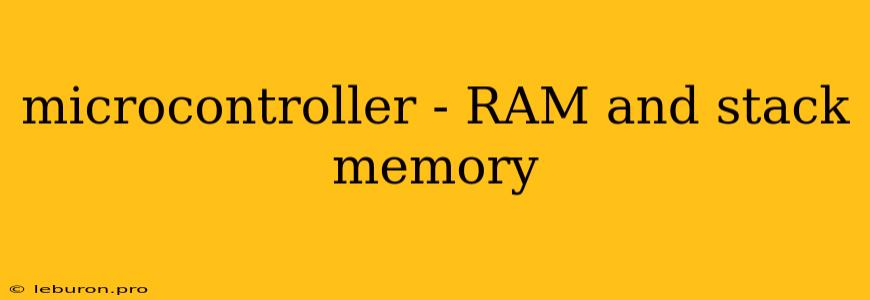Microcontrollers are the brains behind countless embedded systems, from everyday appliances to sophisticated industrial machinery. They are tiny computers designed to perform specific tasks, often with limited resources like memory. Understanding how microcontrollers manage their memory, particularly the distinction between RAM and stack memory, is crucial for efficient programming and reliable system operation. This article delves into the intricacies of RAM and stack memory within the context of microcontrollers, exploring their roles, differences, and implications for software development.
Understanding the Foundation: RAM and Stack Memory
At the heart of any microcontroller lies memory, the essential component for storing and retrieving data. RAM (Random Access Memory) and stack memory are two fundamental types of memory used in microcontrollers. Each plays a distinct role in program execution, and a clear grasp of their differences is vital for optimizing code and preventing potential errors.
RAM: The Workspace
RAM serves as the microcontroller's primary workspace, a temporary storage space where data actively used by the program resides. It allows for quick and direct access to variables, arrays, and other data structures. Imagine it as a desk where you work on a project, with documents, tools, and supplies readily available. Key characteristics of RAM include:
- Random Access: Data can be accessed in any order, making it ideal for applications requiring fast data retrieval.
- Volatility: Data stored in RAM is lost when the microcontroller loses power.
- Limited Capacity: RAM is typically a scarce resource on microcontrollers, necessitating careful allocation and optimization.
Stack Memory: The Call Stack
Stack memory is a different beast entirely. It's a dedicated memory area used to manage function calls and local variables within those functions. Imagine it like a stack of plates, where each plate represents a function call.
Stack Memory Functions:
- Function Calls: When a function is called, a new frame is pushed onto the stack, storing the function's local variables, return address, and other necessary information.
- Local Variables: Variables declared within a function are allocated space on the stack, ensuring that each function has its own isolated environment.
- Return Address: The stack holds the address where the program should return after the function finishes executing.
- LIFO (Last-In, First-Out) Principle: Data is pushed onto and popped off the stack in a specific order. The most recent function call is at the top of the stack, and the oldest function call is at the bottom.
Understanding the Differences: RAM vs. Stack Memory
While RAM and stack memory work together to enable program execution, they have distinct characteristics:
RAM
- Purpose: General-purpose data storage.
- Access: Random access.
- Volatility: Volatile.
- Allocation: Manual allocation by the programmer.
- Storage: Holds variables, arrays, program data.
Stack Memory
- Purpose: Function call management and local variable storage.
- Access: LIFO.
- Volatility: Volatile.
- Allocation: Automatic allocation by the compiler.
- Storage: Holds function call information, local variables, and return addresses.
The Interplay of RAM and Stack Memory
RAM and stack memory work in tandem to enable a microcontroller's execution. When a program starts, the stack is initialized and allocated a portion of the available RAM. As the program runs and functions are called, stack frames are pushed onto the stack, consuming RAM.
Stack Overflow: A critical issue arises when the stack grows too large. This can happen if a function has too many local variables or if the program makes too many nested function calls. If the stack grows beyond the allocated space in RAM, a stack overflow occurs, leading to unpredictable program behavior and potentially a system crash.
Consequences of Stack Overflow:
- Data Corruption: Stack overflow can overwrite critical data in RAM, corrupting program variables and causing incorrect results.
- Program Crash: The program may abruptly terminate due to the stack overrunning into other memory areas.
- Hardware Failures: In severe cases, stack overflow can even cause hardware malfunctions.
Best Practices for Stack Management
To avoid stack overflows and ensure program stability, developers must pay attention to stack management:
- Minimize Local Variable Usage: Reduce the number of local variables within functions to minimize stack usage.
- Avoid Deep Recursion: Limit the depth of nested function calls to prevent excessive stack growth.
- Utilize Static Variables: For data that persists throughout the program's lifetime, use static variables declared outside functions. Static variables are allocated in RAM but do not reside on the stack.
- Stack Size Optimization: Configure the stack size during the microcontroller's initialization process. Ensure the stack size is large enough to accommodate the program's needs without overflowing.
- Use Profilers: Use profiling tools to analyze program execution and identify functions that contribute to stack growth. This allows for targeted optimization efforts.
Conclusion
Understanding the nuances of RAM and stack memory is crucial for microcontroller programming. The distinction between these two types of memory and their respective roles in program execution is fundamental for writing efficient, robust code. By carefully managing stack usage, developers can prevent stack overflows and ensure the reliable operation of embedded systems. Remember, a well-managed stack is the foundation for stable and predictable microcontroller behavior.
